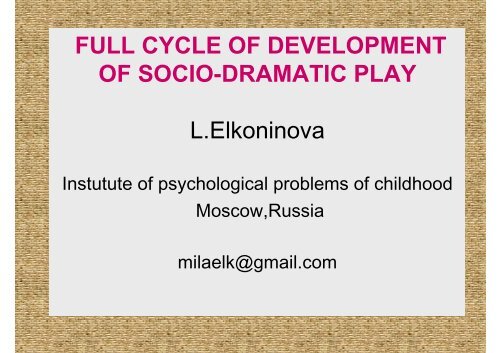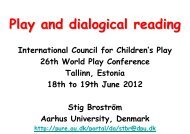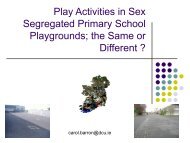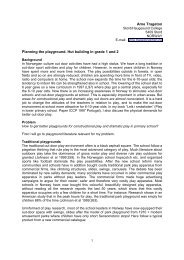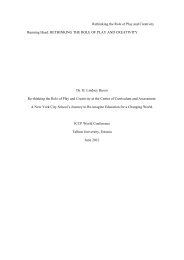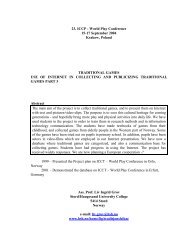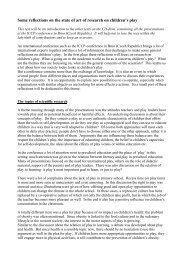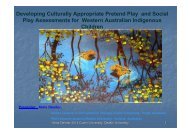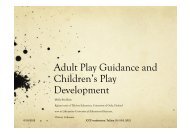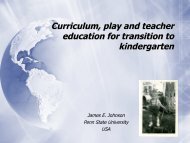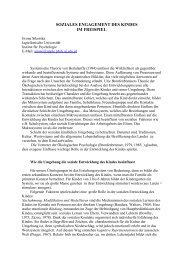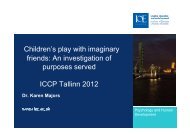Dr Ludmila Elkoninova - International Council for Children's Play
Dr Ludmila Elkoninova - International Council for Children's Play
Dr Ludmila Elkoninova - International Council for Children's Play
You also want an ePaper? Increase the reach of your titles
YUMPU automatically turns print PDFs into web optimized ePapers that Google loves.
FULL CYCLE OF DEVELOPMENT<br />
OF SOCIO-DRAMATIC PLAY<br />
L.<strong>Elkoninova</strong><br />
Instutute of psychological problems of childhood<br />
Moscow,Russia<br />
milaelk@gmail.com
Introduction<br />
The issue of how a socio-dramatic play originates,<br />
“flourishes” and then “wraps up” into a resource of further<br />
development of a child requires fundamental theoretical<br />
research. At the same time, a competent answer to this<br />
question may help to in<strong>for</strong>mally tie the theory and the<br />
practice, and to solve practical tasks in a meaningful way.<br />
This question will be answered here in the<br />
frameworks of the L.S.Vygotsky’s Cultural-historical theory<br />
and Activity theory. In accordance with them, internal mental<br />
processes can be “read out” by the qualitative changes of<br />
the mode of action. Mental development is a transition from<br />
natural (impulsive) action towards the action built on the<br />
new cultural <strong>for</strong>m thanks to which the action becomes<br />
intended and conscious. Description of this qualitative<br />
trans<strong>for</strong>mation is the fixation of development.<br />
2
The definition of a play in general: a free activity, during<br />
which ideal subjects are being tested (examined) – meanings<br />
of activities, internal states and modes of acting. The aim of<br />
such testing activity is to get oriented in the object matter and<br />
within yourself, discovering your own possibilities, uncovering<br />
of yourself. Self-revelation in a play is per<strong>for</strong>med due to the<br />
fact that the person is indeed open to the world of the<br />
potential, the world of the possible. That’s exactly why a play<br />
is unfolded in the <strong>for</strong>m of per<strong>for</strong>mance (enactment,<br />
expressive representation) of certain situations, meanings,<br />
states, actions, or in a <strong>for</strong>m of a competition. The situation of<br />
a play is safe, since the person acts within it conventionally<br />
(“as if”, in the trial regime), however the achieved experience<br />
is real and unconditional, because it has been felt and lived<br />
through during the play. A play trial, in distinction from a<br />
practice exercise, should have cultural <strong>for</strong>m.<br />
3
1.Setting Stage of Socio-<strong>Dr</strong>amatic <strong>Play</strong> at Early<br />
Age (approximately from 1 to 3 years old)<br />
1.1.Meanings, relationships are ideal objects (love, courage) and that’s why<br />
dealing with them differs drastically from the way of dealing with real<br />
objects – tools (a spoon, a hummer). Be<strong>for</strong>e a child can discover, feel<br />
and hold in a play the sense of action (relationships of people), he<br />
should to act intentionally on conditional level, i.e. keep in mind<br />
simultaneously the real and the imaginary meanings. At the early age he<br />
is learning to act ‘as if’ – first in relation to objects (a little stick – as a<br />
substitution <strong>for</strong> a spoon), and then in relation to a role play (I am cooking<br />
dinner like my mummy). A socio-dramatic play cannot achieve its apex<br />
without such preparatory skills. I believe this is exactly what<br />
L.S.Vygotsky meant when he wrote about the Imaginary Situation<br />
(divergence of the perceptible and semantic fields) as a basis to the preschool<br />
children’s plays.<br />
4
1.2.The difficulty is that <strong>for</strong> a child, a word<br />
(image, perception) is merged with the actual<br />
object it defines. That’s why the child’s play is an<br />
Ernstspiel until he/she separates his/her<br />
perceptions from reality, until he/she feels and<br />
identifies them as images, fiction. The child’s<br />
main achievements at the early age – such as<br />
walking, talking and object-related actions –<br />
help him/her to separate a real action from a<br />
“make-belief” action, and spontaneously build<br />
an imaginary action.<br />
5
1.3.Any new experience, including appearance of an image, is always<br />
connected with a bodily sensation. When a child starts to walk, not just a<br />
broad visual space opens up in front of him, but he feels it tonic-kinetically,<br />
he feels the “there” and the “here” with his body. Image at this age is an<br />
action in the visual-body field which is felt by a body. Grown-ups set up<br />
external boundaries of the child’s activity through prohibitions (can go here<br />
– cannot go there). With the appearance of external boundaries, there also<br />
appears a ‘reaction’ to a prohibition – an intended breach of the prohibition<br />
by the child. This is not a whim, but the only possibility to establish, feel the<br />
internal boundaries of an act. It doesn’t come easy with a child: he is<br />
attracted by anything that his eye can catch, however he gradually learns to<br />
separate himself from the outer world. The perception of his own action first<br />
happens in motion. The ‘own/alien’ boundary (external/internal) is felt by a<br />
child on bodily level – well known is the struggle over own space in a<br />
sandpit, children’s “proprietary” mood (this is mine; I’m not giving it back). At<br />
the age of approximately 2,5 years a child starts to realize that it is exactly<br />
he, who is acting: words ‘I myself’ start to appear in his speech.<br />
6
1.4. At this age adults already ask the child, what<br />
he/she wants, give him/her an opportunity to take<br />
own decision what he/she will or will not do. Thus,<br />
he/she learns to refer as his/her not only things, but<br />
also wishes; to feel and to show personal initiative,<br />
which in the future, in development of sociodramatic<br />
play, will become a special subject of the<br />
child’s attention.<br />
Children are read literary books, and they receive<br />
experience of participating in imaginary, fictional life,<br />
although the fairy-tale events are being lived though<br />
by the child as real.<br />
7
1.5. Separation of a word from a real object also happens<br />
through object-related actions comprehensible <strong>for</strong> a child of<br />
this age: a child quickly realizes that a ‘cake’ which he/she<br />
has made out of sand is in fact inedible – and this difference<br />
is once again felt bodily by tasting the cake. The child can<br />
already make jokes, and thus loosens the merge of the word<br />
and the object.<br />
Eventually, at the early age there appears a toy per<br />
se: a child is given to know that one doesn’t play with a bed<br />
pan like with a doll or a toy car. At the end of this age range<br />
a child is able to per<strong>for</strong>m a story with a sequence of<br />
consecutive actions, but this is still not the type of a play,<br />
where he/she intentionally explores and discovers human<br />
relation. This type of a play is the next stage of<br />
development.<br />
8
2. “Ideal” Socio-<strong>Dr</strong>amatic <strong>Play</strong><br />
2.1 What is the criterion that an outside observer can use to<br />
responsibly define a moment when a child is developing in a<br />
play? In fact, actions in a play are conditional and abridged,<br />
they are not always accompanied by the word, the meaning of<br />
gestures is clear only from the ‘inside’ of the play, children are<br />
all the time distracted from the initial plot and change the<br />
assumed roles many times. At the same time, <strong>for</strong> the child<br />
involved in the play, the meaning of the play action is<br />
unconditional and real (in a play, everything is conditional but<br />
the meaning). How and with which “sensor” does he/she feel<br />
the meaning (purpose) and by which means an outside<br />
observer watching the child’s play can “point a finger” at that<br />
meaning?<br />
9
2.2. According to L.S.Vygotsky, patterns of behavior<br />
are prescribed in culture, and there<strong>for</strong>e there is a<br />
prototype of an “ideal” playing plot, within which the<br />
meaningful side of the action has been prescribed in<br />
a comprehensive <strong>for</strong> the preschoolers <strong>for</strong>m. This<br />
cultural plot is the ‘bearer’ of a certain general mode<br />
of building a socio-dramatic play, by which a child is<br />
testing and experiencing the meaning of the action.<br />
Studies have shown that it’s a fairy-tale, in which<br />
patterns of taking initiative are specified, or, in other<br />
words, active decision taking. It is exactly initiative<br />
taking that is being tested by a child in a sociodramatic<br />
play.<br />
10
2.3. The <strong>for</strong>m (structure) of an ideal playing plot,<br />
where the meaning of an action is highlighted,<br />
consists of two parts, or steps. The first step of a<br />
play plot consists of a sequence of playing<br />
actions with which a child creates the situation<br />
of expectation of some sort of a role action,<br />
creates circumstances containing a question<br />
towards characters in the play. This sequence of<br />
actions has a symbolic meaning of triggering<br />
role action. The second step is a sequence of<br />
role actions, symbolic meaning of which is the<br />
response to this challenge.<br />
11
2.4. There<strong>for</strong>e, the question by which sensors and<br />
how a child feels human relations we can answer as<br />
follows: if in a playing plot he/she is trying to create<br />
two steps – the one of a challenge and the one of<br />
the reaction to the challenge, then his/her focus of<br />
attention is the meaning of action. This is exactly the<br />
trial of relationships, i.e. the moment of the child’s<br />
development within play. Besides the two steps, the<br />
full <strong>for</strong>m of play has the following characteristics:<br />
1. every step has its own time and space<br />
characteristics;<br />
2. the child connects the two steps at his/her will,<br />
constructs a 'bridge' between them;<br />
3. finally, there is a conflict, a collision in the play.<br />
12
2.5. The concept of a two-steps <strong>for</strong>m of a play<br />
helps dividing children’s plays into three groups:<br />
plays with a full two-steps <strong>for</strong>m; plays with a<br />
reduced <strong>for</strong>m (children play out just one part/step,<br />
and the other one they only keep in mind); and<br />
poorly structured plays. Development is<br />
associated only with two-step play, in the other<br />
plays the two-step structure is reduced, and these<br />
plays are associated not with development, but<br />
with functional pleasure. The unit of a play is not<br />
one role, but the relationship of two roles: the<br />
challenging one and the answering one.<br />
13
2.6. The sensual material of the play is an initial,<br />
spontaneous emotional state caused by some event,<br />
something that caught the child's attention, impressed<br />
him/her, provoked his/her reaction. The experienced<br />
event affects the child existentially, necessarily<br />
touches upon the consciousness of his life. The child<br />
takes such an event more or less emotionally, more or<br />
less distinctively, but the significant thing is that the<br />
child does not understand its meaning. It can be, <strong>for</strong><br />
instance, the feeling of solitude when the child is sent<br />
to nursery school, fear, envy, and grievance. The word<br />
combination “assignment of meaning” pushes towards<br />
understanding of a play as a process of finding out the<br />
ready-made, but not exactly clears where lying<br />
14<br />
meaning. This is not so.
2.7. By giving the sensual material a two-steps <strong>for</strong>m, a child<br />
generates the meaning, he/she creates it. The meaning as an<br />
object exists only when it is being lived through. By playing, a<br />
child objectifies his/her inner world, makes it representable –<br />
he/she shapes it as a plot, turns it into a story with events.<br />
He/she constructs a situation, in which a natural experience has<br />
occurred – since if one cannot feel it, then there is nothing to<br />
shape, there is nothing to overcome. He/she creates a space<br />
where the collision has happened, evokes the conflict anew,<br />
acts with it upon him/herself (challenge), and tries to respond to<br />
his/her feeling with an action, to find release to his/her feeling<br />
(catharsis). This doesn’t happen easy with a child. The child<br />
tries ‘successfulness’ of a conflict-resolving action through<br />
repetitions, with the help of which successfulness of an action is<br />
being felt again and again, and it is tested. Two-step <strong>for</strong>m of a<br />
play is a functional organ, with the help of which the<br />
meaning is being lived through and generated.<br />
15
2.8. This is difficult because of two reasons.<br />
First, a child needs to find him/herself an action<br />
suited <strong>for</strong> the first and/or second step; to create the<br />
plot, fulfill gaps in it. This moment explains<br />
unpredictability and creativity of a play. The<br />
connection between the challenge and the response<br />
is culturally defined in the structure of the ‘text of a<br />
play’ – the semantic fields.<br />
Secondly, it’s because the emotional material itself<br />
maintains resistance. This is the main internal<br />
reason why it is not easy <strong>for</strong> children to create a plot<br />
<strong>for</strong> two-step plays.<br />
16
2.9.<br />
A child him/herself builds his/her playing space, which has<br />
external geography: he/she generates two (or more) fields<br />
opposite by meaning within it (semantic spaces, the own<br />
and the alien) and the borderline between them, and as<br />
well role action, which crosses and binds these spaces (i.e.<br />
this action has its own chronotope).<br />
By building a challenge and the response, a child<br />
correlates intention and implementation: he/she corrects<br />
the intention, if implementation on the challenge doesn’t<br />
work out, or he/she changes playing actions of the<br />
response to the challenge. One can observe separation of<br />
the intention from action implementation when children<br />
about 5 years old select a topic <strong>for</strong> the play be<strong>for</strong>e it is<br />
started (“let’s play hospital”) and their roles (“I am a<br />
doctor”).<br />
17
3. Socio-<strong>Dr</strong>amatic <strong>Play</strong> as a Resource<br />
3.1.Study of the impact of socio-dramatic play on<br />
the mental development is difficult since it is built<br />
into the whole life of a child, and an artificial<br />
scientific experiment could distort the real picture.<br />
This is the reason why the developmental function<br />
of play has not been explored sufficiently.<br />
We find it important to highlight not the didactical<br />
possibilities of play but what happens to child’s<br />
action thanks to socio-dramatic play.<br />
18
3.2. Only in socio-dramatic play, child’s attention is<br />
<strong>for</strong> the first time centered on intention (purpose),<br />
desire; it is marked by the child as a separate<br />
reality. This qualitative change of action is<br />
connected with the <strong>for</strong>m of action – it is <strong>for</strong> the<br />
child him/herself divided into two components:<br />
intention and implementation. The child<br />
spontaneously and according to his/her owns will<br />
learn how to coordinate these components,<br />
moving back-and-<strong>for</strong>th between them. <strong>Play</strong>s with a<br />
long sequence of consecutive events encourage<br />
appearance of a program of implementation of<br />
action.<br />
19
3.3. Coordination of intention and implementation in a<br />
play encourages appearance of positional<br />
(decentered) action which may appear already in<br />
late pre-school age, <strong>for</strong> instance, in a puppet theater<br />
per<strong>for</strong>med by the children themselves. Transition from<br />
playing action towards scenic action may occur in it.<br />
The essence of positional nature of scenic action is<br />
retention by the child of two things simultaneously:<br />
not only the mode of unfolding the per<strong>for</strong>mance, but<br />
also the reaction of the spectator.<br />
The experience of referring the intention and the<br />
action implementation program serves as a foundation<br />
<strong>for</strong> the task-oriented <strong>for</strong>m of the child’s work at<br />
school, <strong>for</strong> example, at solving math problems, writing<br />
20<br />
compositions or at creative activity (drawing etc).
Conclusions<br />
21
THANK YOU<br />
FOR ATTENTION!<br />
22


